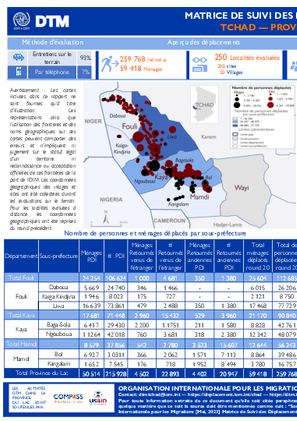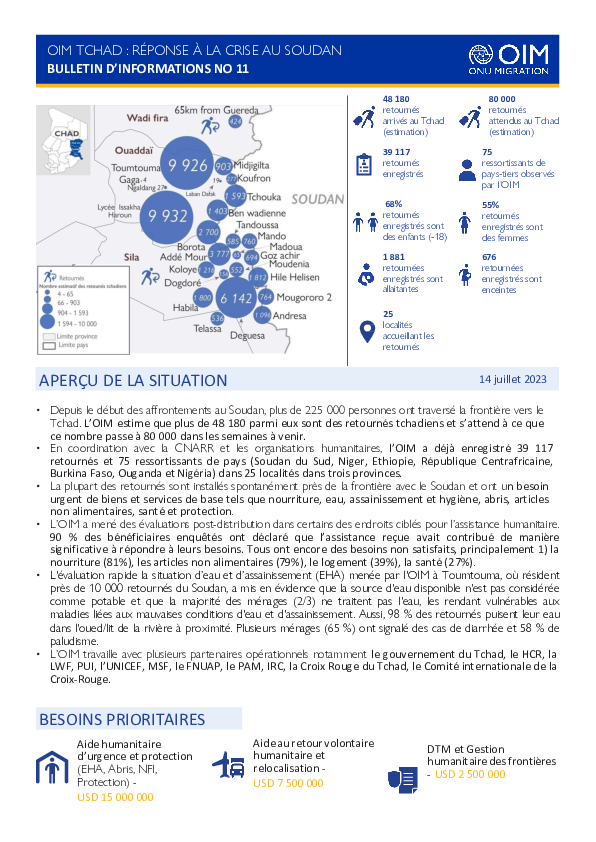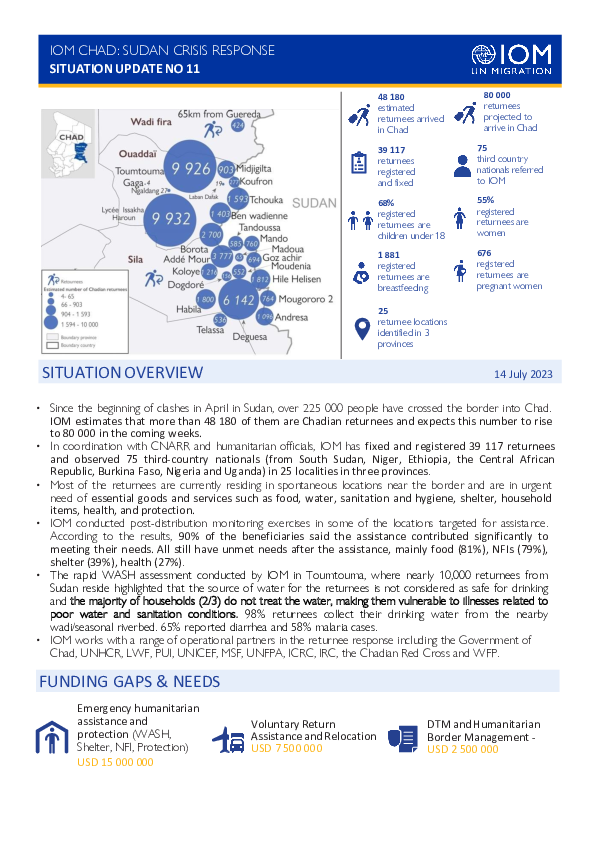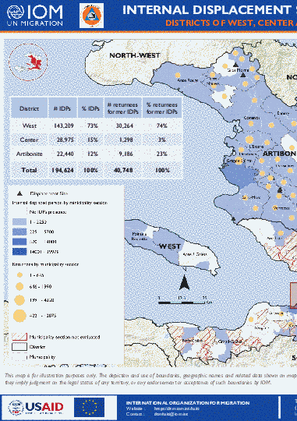-
Countries
-
Data and Analysis
-
Special Focus
-
Crisis Responses
The Central Sahel area, and in particular the Liptako Gourma region, which borders Burkina Faso, Mali and Niger, is affected by a complex crisis involving growing competition over dwindling resources; climatic variability; demographic pressure; high levels of poverty; disaffection and a lack of livelihood opportunities; communal tensions; the absence of state institutions and basic services; and violence related to organized crime and non-state armed groups. The crisis has triggered significant displacement of populations in the concerned countries and is affecting neighbouring countries such as Mauritania and the coastal countries.
As of June 2023, 2,869,892 individuals have been displaced, including 2,614,709 internally displaced persons (91% of the displaced population) and 255,183 refugees (9% of the displaced population). Seventy-three per cent of the displaced populations (2,098,917 individuals) were located in Burkina Faso, while 14 per cent resided in Mali (410,039 individuals), 8 per cent in Niger (233,041 individuals) and 3 per cent in Mauritania (98,474 individuals). The crisis’ recent spill over to coastal countries, namely Côte d’Ivoire, Ghana, Togo and Benin, shows growing number of refugees coming from the Central Sahel and populations internally displaced. As of June, 29,421 individuals were affected by displacement within the four countries (2,294 in Benin, 6,316 in Côte d’Ivoire, 6,311 in Ghana and 14,500 in Togo) of which 10,397 were internally displaced.
The crisis currently affecting the Lake Chad Basin states results from a complex combination of factors, including conflict with non-state armed groups, extreme poverty, underdevelopment and a changing climate, which together have triggered significant displacement of populations. As of June 2023, Cameroon, Chad, Niger and Nigeria were hosting an estimated 6,061,037 affected individuals made up of internally displaced persons (IDPs), returnees (former IDPs and returnees from abroad) and refugees (both in- and out-of-camp).

Contact
DTM South Sudan, SouthSudanDTM@iom.int
Language
English
Location
South Sudan
Period Covered
Dec 01 2021
Dec 31 2021
Activity
- Mobility Tracking
- Baseline Assessment
This atlas contains a summary of findings from the twelfth round of Mobility Tracking conducted across South Sudan through key-informants based assessment at payam and location level between as of December 2021. Mobility Tracking quantifies the presence of internally displaced persons (IDPs) and returnees in South Sudan in displacement sites and host communities. IOM DTM mapped a total of 2,229,657 IDPs (including 7% previously displaced abroad) and 1,924,368 returnees (including 33% from abroad) in 3,654 locations across South Sudan as of December 2021.
Contact
DTMMali@iom.int
Location
Mali
Activity
- Mobility Tracking
- Baseline Assessment
Period Covered
Dec 01 2022 -Dec 31 2022
During the data collection and update operation carried out in December 2022, a total of 412,387 IDPs were identified. The number of IDPs has indeed fallen from 440,436 people in September 2022 (September 2022 CMP report) to 412,387 in December 2022. Thus from September to December 2022, a decrease of 28,049 displaced people (about 6.4% of decrease) was observed.
Population Groups
Survey Methodology
Unit of Analysis Or Observation
Type of Survey or Assessment
Keywords
Geographical Scope
Administrative boundaries with available data
The current dataset covers the following administrative boundaries

Contact
DTM Tchad, dtmtchad@iom.int
Language
French
Location
Chad
Period Covered
Mar 26 2023
May 08 2023
Activity
- Mobility Tracking
- Site Assessment
- Baseline Assessment
Depuis 2015, le Tchad fait l’objet d’attaques perpétrées par des groupes armés non-étatiques présents dans le bassin du Lac Tchad engendrant des déplacements massifs de populations, aussi bien internes que transfrontaliers. Au Tchad, l’OIM met en œuvre sa Matrice de suivi des déplacements (DTM, Displacement Tracking Matrix en anglais) dans la province du Lac depuis mai 2015 pour mesurer l’évolution du nombre, des profils et les besoins des populations déplacées suite à cette crise, afin de mieux orienter les programmes humanitaires et de développement. Les données sont collectées à travers des entretiens avec des informateurs clés (autorités locales, chefs traditionnels, représentants des personnes déplacées et gestionnaires de sites) dans les villages et sites d’accueil des personnes déplacées, ainsi que par des observations directes dans ces localités.
Ce tableau de bord présente les résultats d'évaluations menées entre le 26 Mars – 08 Mai 2023 dans 250 lieux de déplacement. Il y a eu une augmentation globale de 2 % par rapport au round précédent. Cette légère augmentation peut être attribuée au fait que l'évaluation a été réalisée pendant la période du Ramadan, au cours de laquelle certaines communautés rentrent pour être en famille. Cela est également dû à l'augmentation de 4% des PDI due à l'augmentation des nouveaux déplacements en avril à cause des attaques armées et par peur (ETT 166). Il est à noter qu'au cours du round 20 les informateurs clés ont signalés 14% des sites comme accueillant des personnes déplacées par les inondations.
Il a également été constaté que les retournés anciennes PDI n'étaient pas présents dans les quelques sites de retour qui existent à Daboua et Kaiga-Kinjiria au moment de la collecte des données, en raison des activités agricoles et de pêche en dehors de leur lieu de résidence habituel. Ce groupe est le plus mobile en termes d'activités de subsistance, et la plupart des membres des communautés signalent des mouvements pendulaires. Cette collecte de données a été réalisée en partenariat avec la Commission Nationale d'Accueil de Réinsertion des Réfugiés et des Rapatriées (CNARR) et l'Association pour l'Action Humanitaire et le Développement Durable (ACHDR), le cluster CCCM, le Ministere de la Prospective Economique et des Partenariats Internationaux (MdP) et l’Institut National de la Statistique, des Etudes Economiques et Démographiques (INSEED) afin d'orienter les résultats vers la planification de solutions durables pour les personnes déplacées.

Contact
DTM Chad, dtmtchad@iom.int
Language
French
Location
Chad
Period Covered
Jul 14 2023
Jul 14 2023
Activity
- Flow Monitoring Survey
- Flow Monitoring
Depuis le début des affrontements au Soudan, plus de 225 000 personnes ont traversé la frontière vers le Tchad. L’OIM estime que plus de 48 180 parmi eux sont des retournés tchadiens et s’attend à ce que ce nombre passe à 80 000 dans les semaines à venir. En coordination avec la CNARR et les organisations humanitaires, l’OIM a déjà enregistré 39 117 retournés et 75 ressortissants de pays (Soudan du Sud, Niger, Ethiopie, République Centrafricaine, Burkina Faso, Ouganda et Nigéria) dans 25 localités dans trois provinces.
La plupart des retournés sont installés spontanément près de la frontière avec le Soudan et ont un besoin urgent de biens et services de base tels que nourriture, eau, assainissement et hygiène, abris, articles non alimentaires, santé et protection. L’OIM a mené des évaluations post-distribution dans certains des endroits ciblés pour l’assistance humanitaire. 90 % des bénéficiaires enquêtés ont déclaré que l’assistance reçue avait contribué de manière significative à répondre à leurs besoins. Tous ont encore des besoins non satisfaits, principalement 1) la nourriture (81%), les articles non alimentaires (79%), le logement (39%), la santé (27%). L'évaluation rapide la situation d’eau et d’assainissement (EHA) menée par l'OIM à Toumtouma, où résident près de 10 000 retournés du Soudan, a mis en évidence que la source d'eau disponible n'est pas considérée comme potable et que la majorité des ménages (2/3) ne traitent pas l'eau, les rendant vulnérables aux maladies liées aux mauvaises conditions d'eau et d'assainissement. Aussi, 98 % des retournés puisent leur eau dans l'oued/lit de la rivière à proximité. Plusieurs ménages (65 %) ont signalé des cas de diarrhée et 58 % de paludisme.
L’OIM travaille avec plusieurs partenaires opérationnels notamment le gouvernement du Tchad, le HCR, la LWF, PUI, l’UNICEF, MSF, le FNUAP, le PAM, IRC, la Croix Rouge du Tchad, le Comité internationale de la Croix-Rouge.

Contact
DTM Chad, dtmtchad@iom.int
Language
English
Location
Chad
Period Covered
Jul 14 2023
Jul 14 2023
Activity
- Flow Monitoring Survey
- Flow Monitoring
Since the beginning of clashes in April in Sudan, over 225 000 people have crossed the border into Chad. IOM estimates that more than 48 180 of them are Chadian returnees and expects this number to rise to 80 000 in the coming weeks.
In coordination with CNARR and humanitarian officials, IOM has fixed and registered 39 117 returnees and observed 75 third-country nationals (from South Sudan, Niger, Ethiopia, the Central African Republic, Burkina Faso, Nigeria and Uganda) in 25 localities in three provinces. • Most of the returnees are currently residing in spontaneous locations near the border and are in urgent need of essential goods and services such as food, water, sanitation and hygiene, shelter, household items, health, and protection. IOM conducted post-distribution monitoring exercises in some of the locations targeted for assistance. According to the results, 90% of the beneficiaries said the assistance contributed significantly to meeting their needs. All still have unmet needs after the assistance, mainly food (81%), NFIs (79%), shelter (39%), health (27%).
The rapid WASH assessment conducted by IOM in Toumtouma, where nearly 10,000 returnees from Sudan reside highlighted that the source of water for the returnees is not considered as safe for drinking and the majority of households (2/3) do not treat the water, making them vulnerable to illnesses related to poor water and sanitation conditions. 98% returnees collect their drinking water from the nearby wadi/seasonal riverbed. 65% reported diarrhea and 58% malaria cases.
IOM works with a range of operational partners in the returnee response including the Government of Chad, UNHCR, LWF, PUI, UNICEF, MSF, UNFPA, ICRC, IRC, the Chadian Red Cross and WFP.

Contact
DTM South Sudan, SouthSudanDTM@iom.int
Language
English
Location
South Sudan
Period Covered
Jul 01 2022
Aug 31 2022
Activity
- Mobility Tracking
- Baseline Assessment
This atlas contains a summary of findings from the thirteenth round of Mobility Tracking conducted across South Sudan through key-informants based assessment at payam and location level between July and August 2022. Mobility Tracking quantifies the presence of internally displaced persons (IDPs) and returnees in South Sudan in displacement sites and host communities. IOM DTM mapped a total of 2,257,672 IDPs (including 7% previously displaced abroad) and 2,175,352 returnees (including 29% from abroad) in 3,614 locations across South Sudan as of August 2022.

Contact
DTM Haiti, DTMHaiti@iom.int
Language
English
Location
Haiti
Period Covered
Jun 12 2023
Jul 03 2023
Activity
- Mobility Tracking
- Site Assessment
- Baseline Assessment
- Village Assessment
In recent years, widespread insecurity in Haiti has caused thousands of people to flee their areas of residence. Although the violence most often occurs in the Metropolitan Zone of Port-au-Prince (ZMPP) located in the West district, other departments are also affected. This is particularly the case for the Center and Artibonite ones.
In order to regularly inform authorities as well as other partners on the displacement situation in the West, Center and Artibonite districts, the General Directorate of Civil Protection (DGPC) and IOM's Displacement Tracking Matrix (DTM) carried out in June 2023, assessments in communal sections, neighborhoods and sites hosting displaced populations in these districts.
This dashboard presents the summary of results from these data collections


